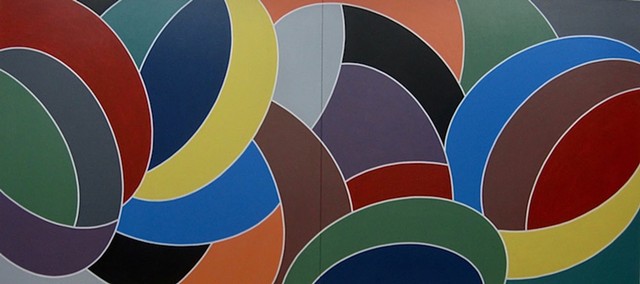The labyrinth is an ancient symbol that suggests a refuge or rite of passage going back in time to the mystery cults of Dionysus. The labyrinth can also function as a metaphor for a life-map. Since 1991, I have been developing a series of paintings and drawings that use the image of a labyrinth or maze. It is this understanding of the labyrinth, as a way of mapping one’s movement through life that imbues the content of my work. My past work has often dealt with themes of passage or redemption as some of my older titles would indicate: the Passage, Survivor, and Sanctuary Series.
Jorge Luis Borges suggests that the labyrinth is a form of sanctuary because we feel lost in the world and can lose ourselves in its embrace. In the earlier works I tended to locate an image in the heart of the labyrinth as a reward for the journey; in others, I superimposed the image of a maze over a landscape or tree, suggesting nature and culture in some kind of tenuous relationship.
Recently I have begun to explore our passage from modernism to postmodernism, from a centered self to a decentered self. Frederic Jameson refers to this loss of centeredness in the blur of global technological change as the postmodern sublime. In these drawings and paintings, I have employed utopian images of modernity--a Mondrian painting, a space shuttle, a communication satellite--that suggest cultural and technological progress. These same images are juxtaposed with the Ebola virus, one of the most deadly viruses to emerge in recent times. The virus becomes a metaphor of our loss of control over nature and modernism’s dream of that conquest which began with the Enlightenment and the Age of Reason. Moreover, this thematic exploration of the death of modernity has led me to investigate, through a series of new paintings, the visual possibilities of city maps as urban condensers of control and signifiers of civilization with all its inherent conceits and, also, as maze-like images that suggest metaphors for life’s passages.
My work has been primarily geometric, inspired by the great utopian notions of late modernism (the cult of the right angle). More recently, I have adopted a curved matrix that intertwines, creating a maze-like form. To this entangled network I introduced circles and ovoid shapes that often invade or attach themselves to the coiled pathways. The resultant image suggests a myriad of possible interpretations: ominous growth, viral or cellular activity, internal organs, forms of nature.
The Tango Series is a group of paintings I have been developing since 2009. It grew out of the Labyrinth Series and continues to explore the theme of unpredictable passages through ones' life. For this recent body of work I have focused on one motif, the intertwined oval configuration. I am continuing to use abstraction semiotically to express concerns of entanglement, puzzlement, connectedness, and disconnectedness. The personal metaphor also moves to a larger context of the global and the present day multitude of world problems. The painting's images of intertwined, disconnected ovals reference a Global state of complication, confusion, and perplexity. Moreover, the paintings are, like their title, about the dance; its movement, precision, and seduction.
Of course the above is a moot point if the paintings do not work visually as compelling objects. There are obviously many formal decisions in the making of the work; decisions of color, design, scale, and medium. Finally, my concepts for the work are what generate it initially, but it is always open to the viewer to interpret the work as they see it.
